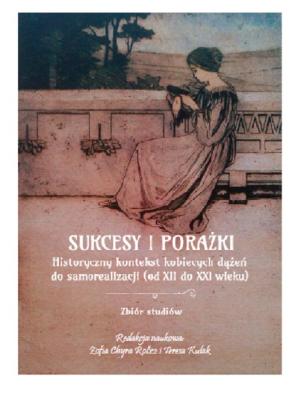Wokół zindywidualizowanych doświadczeń przełamywania barier obyczajowych i obowiązującego konwenansu w twórczości literackiej George Sand, Zofii Trzeszczkowskiej oraz Barbary Rosiek
Streszczenie
This paper deals with the problem of overcoming and breaking women’s necessity to camouflage across time and custom changes presented in literary works written by women living in different p eriods and places. Individual aspirations and experiences of three women writers are discussed by the author. The first is French famous writer Aurora Dudevant (1804 1804-1876), an aristocratic lady with a male penname of George Sand. She was well known and ve ry popular in social circles in Paris and
Europe at that time. The fact that she wore men’s clothes in everyday life sometimes and usually used a male penname in literary works helped her to survive the possible consequences of her very courageous activi ties causing scandal, and helped her to express her point of view in a world with two distinct morality codes – one for men and the other for women. The second writer – Zofia Trzeszczkowska (1847 1847-1911) – lived very far from Paris, the cultural capital of the world at that time. She spent her life on the Polish territory under the rule of the Russian Empire, dividing her life
between provincial homes and trips to a town or abroad. Born to an impoverished gentry family, she married a military man, with whom she travelled into the Balkans during the Russo Russo-Turkish War, in a man’s clothing. She disguised herself as a man for a very long time, also in literary works, being afraid of shame for her unconventional activity of a woman with the background of her socia l class of provincial small landowners. Today she has been forgotten. The third one – Barbara Rosiek (1959 1959-2020) – belongs to the present present-day generation of Polish writers, who talk very openly about
her way of life, problems and feelings. As a teenager, sh e was addicted to drugs, jeopardizing her health, but she overcame her illness, completed her higher education, and made her name as a successful writer, helping young people with similar problems. Those three women from three different epochs, with differ ent personalities and social status were divided by time and space and life experiences. What did they have in common? It was their literary talent, passion for creation, consequence, and persistence in following their own way of life, strong urge to face the reality, paying a high price, which all helped them cross many barriers and difficulties difficulties.
Pobrania
Zapowiedzi
Licencja

Utwór dostępny jest na licencji Creative Commons Uznanie autorstwa – Użycie niekomercyjne 4.0 Międzynarodowe.





